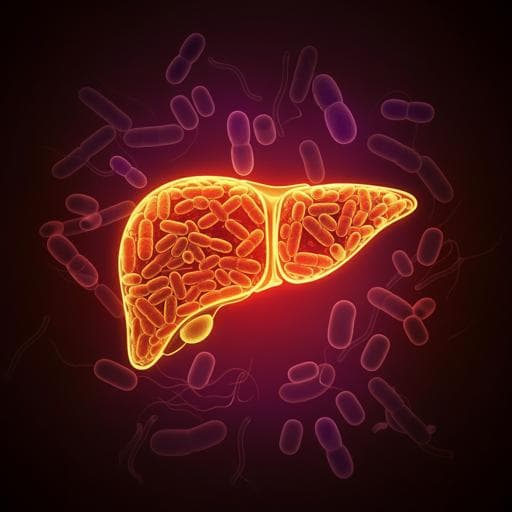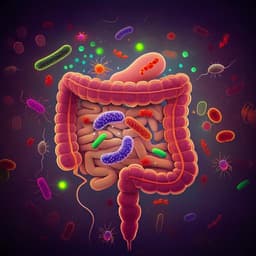
Veterinary Science
Consumption of a high energy density diet triggers microbiota dysbiosis, hepatic lipidosis, and microglia activation in the nucleus of the solitary tract in rats
D. M. Minaya, A. Turlej, et al.
This groundbreaking research conducted by Dulce M. Minaya and colleagues reveals that consumption of high energy density diets leads to significant changes in body composition, gut microbiome, and systemic inflammation in rats. Discover the early responses of microbiota dysbiosis and how these contribute to liver fat accumulation and brain microglia activation over the course of 26 weeks.
~3 min • Beginner • English
Introduction
The study addresses how long-term consumption of a high energy density (HED) diet drives the onset and progression of systemic alterations linked to obesity, including gut microbiota dysbiosis, adiposity, hepatic steatosis, neuroinflammation (microglial activation in the NTS), and systemic inflammatory signaling. Obesity is characterized by chronic low-grade inflammation; excess energy intake enlarges adipose depots and alters adipokine profiles, shifting macrophage phenotypes toward proinflammatory states and activating innate immune pathways (e.g., TLRs). HED diets are known to rapidly remodel the gut microbiota, which may contribute to metabolic syndrome and NAFLD via gut-liver and gut-brain axes. The study’s purpose is to define a temporal sequence of changes induced by HED feeding in rats and to test whether HED progressively alters microbiota, increases leptin/insulin and proinflammatory cytokines, induces NAFLD, and elevates microglial activation in the NTS.
Literature Review
Methodology
- Design and animals: Male Sprague-Dawley rats (n=15; ~300 g) housed individually, 12:12 h light:dark, ad libitum access to chow and water. All procedures approved by IACUC.
- Diets and groups: After 1-week acclimation, rats were maintained on low energy density (LED) diet for 2 additional weeks, then switched to HED diet. LED: 5% fat, 3.25% sucrose (PicoLab 5053). HED: 45% fat, 20% sucrose (Research Diets D12451). Short-term HED (ST-HED): 6 rats sacrificed after 4 weeks on HED. Long-term HED (LT-HED): remaining 9 rats maintained on HED for 26 weeks. Age-matched LED controls for endpoint comparisons: LED26 (n=9).
- Measurements: Food intake recorded twice weekly; body weight and body composition (fat mass) measured weekly using minispec LF 110 BCA Analyzer.
- Sample collection timeline: Blood serum and fecal samples collected at baseline (LED), and at 1, 4, 8, and 26 weeks after HED introduction.
- Serum assays: Cytokines and chemokines measured via Rat Cytokine ELISA Kit (Signosis EA-4006). Insulin measured via Rat Insulin ELISA (ALPCO 80-INSRT-E01). Leptin also measured by ELISA. Serum stored at −21 °C until assay.
- Microbiome profiling: Fecal bacterial DNA extracted (Zymo Quick-DNA Fecal/Soil Microbe Miniprep). 16S rRNA gene (V3–V4) amplicons sequenced (Illumina MiSeq paired-end). Primers: S-D-Bact-0341-b-S-17 (5'-CCTACGGGNGGCWGCAG-3') and S-D-Bact-0785-a-A-21 (5'-GACTACHVGGGTATCTAATCC-3'). Reads trimmed, joined, quality filtered. OTU picking and alpha/beta diversity via QIIME. Differential taxa via LEfSe. Normalization by log-transformation; statistical analyses and PCA via METAGENassist.
- Euthanasia and tissue processing: CO2 anesthesia and transcardial perfusion with PBS then 4% paraformaldehyde. Hindbrains and livers postfixed (2 h), cryoprotected in 30% sucrose/0.1% NaN3 in PBS at 4 °C.
- Microglia activation: Hindbrain cryosections (20 μm) immunostained with Iba-1 (Wako 019-19741) and Alexa-488 secondary. Imaging via Nikon fluorescence microscope; Iba-1 area fraction quantified using Nikon Elements AR.
- Hepatic lipidosis: Livers paraffin-embedded for H&E (4 μm) and OCT-embedded for Oil Red O (ORO, 7 μm). Microscopy with Olympus BX41 and DP25 camera. Semi-quantitative grading scale (0=normal to 4=marked). ORO quantified via Nikon Elements AR.
- Statistics: GraphPad Prism 7. Data as mean ± SD. Comparisons by two-tailed t-tests or ANOVA with Holm–Sidak post hoc as appropriate. Alpha=0.05. Blinded processing. ST-HED and LT-HED groups analyzed independently; endpoint cross-sectional comparisons with LED26 controls.
Key Findings
- Intake, weight, adiposity:
- Initial hyperphagia: Caloric intake increased during first week of HED vs LED (Ps < 0.0001), then returned to LED levels and stabilized.
- Body weight: Significantly higher after 1 week of HED vs baseline (Ps < 0.05) and continued to increase.
- Body fat: Percent fat significantly increased after 1 week vs baseline (Ps < 0.05) and continued to rise.
- Endpoint (26 weeks): Caloric intake similar between HED26 and LED26; body weight higher in HED26 (P=0.006) and fat mass higher (P < 0.0001).
- Microbiota dysbiosis and diversity:
- ST-HED: Shannon diversity decreased after 1 week of HED vs baseline (P=0.0146); no further significant diversity changes at 4 weeks. PCA: HED1 and HED4 profiles shifted away from baseline.
- Taxa shifts (ST-HED): Firmicutes increased (LED 27% → HED1 86% and HED4 69%, Ps < 0.0001); Bacteroidetes decreased (LED 67% → HED1 10% and HED4 16%, Ps < 0.0001); Verrucomicrobia increased at 4 weeks (LED 1% / HED1 0.8% → HED4 8%, P=0.04). Family-level: Erysipelotrichaceae increased (LED 3.8% → HED1 60% and HED4 41%, Ps < 0.0001); family 524-7 (Bacteroidetes) decreased (LED 69% → HED1 12% and HED4 17%, Ps < 0.0001). Firmicutes:Bacteroidetes ratio increased (LED 0.4 → HED1 8.7, P=0.0010; HED4 4.3).
- LT-HED: PCA showed HED-fed animals clustered together and away from LED26. At family level: Ruminococcaceae higher at HED4/HED8 vs HED26 (P < 0.01); Verrucomicrobiaceae lower at HED4/HED8 vs HED26 (P < 0.01). Versus LED26, HED groups had higher Bacteroidaceae and Ruminococcaceae (Ps < 0.0001) and lower Peptostreptococcaceae and Verrucomicrobiaceae (Ps < 0.05 to < 0.01). F:B ratio higher at HED8 vs HED4 and HED26 (11.5 vs 6.4 and 5.7, Ps < 0.01); compared to LED26, HED4 and HED26 had lower F:B ratios (Ps < 0.01).
- Cytokines, leptin, insulin:
- ST-HED (paired): After 4 weeks, TNFα increased (P=0.03); IL-1α decreased (P < 0.0001); no other significant changes.
- LT-HED (longitudinal vs LED): At 4 weeks, FGFβ, MCP-1, MIP-1α, TGFβ increased (Ps < 0.05). At 8 weeks, IFNγ and IL-15 decreased vs LED (Ps < 0.01); TNFα and IL-6 lower than at HED4 (Ps < 0.05). At 26 weeks, FGFβ, leptin, SCF, and MCP-1 higher than LED, HED4, and HED8 (various Ps < 0.05), IP-10 higher vs HED4 (P=0.0094); MIP-1α, IL-15, IL-1α higher than HED8 (Ps < 0.05); Rantes lower vs LED, HED4, HED8 (Ps < 0.05); IFNγ and IL-5 lower vs LED (Ps < 0.01). Cross-sectional HED26 vs LED26: higher leptin, SCF, IL-1α, TGFβ (Ps < 0.01). Insulin showed no significant change.
- Microglia activation (Iba-1) in intermediate NTS:
- HED increased Iba-1 area fraction vs LED26 at 4 weeks (P=0.0005) and 26 weeks (P < 0.0001); HED26 > HED4 (P=0.0213), indicating progressive activation.
- Hepatic lipidosis:
- Histology (H&E, ORO) showed hepatocellular lipidosis apparent by 4 weeks of HED; LED26 showed none. Semi-quantitative scores indicated presence at HED4 and HED26 without significant difference between HED4 and HED26. ORO binary area fraction increased progressively: LED26 0.0099 ± 0.01; HED4 0.0449 ± 0.01; HED26 0.0629 ± 0.02.
Discussion
The findings delineate a temporal cascade initiated by HED feeding: rapid gut microbiota dysbiosis emerges within one week, marked by reduced diversity and pronounced taxonomic shifts (increased Firmicutes/Erysipelotrichaceae, decreased Bacteroidetes and Verrucomicrobiaceae). This early dysbiosis precedes and likely contributes to hepatic lipid accumulation detected by 4 weeks, consistent with gut–liver axis mechanisms whereby microbial products influence hepatic metabolism. Concurrently, neuroinflammation manifests as microglial activation in the intermediate NTS after 4 weeks and intensifies by 26 weeks, supporting a gut–brain inflammatory pathway and vagal remodeling with HED diets. Systemic inflammatory signaling shows broader alterations after prolonged exposure (26 weeks), including elevations in leptin, MCP-1, SCF, FGFβ, and TGFβ and reductions in certain cytokines (e.g., IFNγ, IL-5), reflecting chronic low-grade inflammation associated with obesity. Despite normalization of caloric intake after the first week, HED-fed rats accrued more body weight and adiposity than LED controls, indicating that diet composition drives adverse metabolic outcomes independent of total energy intake. The sustained enrichment of SCFA-producing Ruminococcaceae alongside increased hepatic lipid content suggests complex microbiota–host interactions; SCFAs may modulate hepatic lipid handling and potentially limit progression beyond steatosis. Overall, the results support the hypotheses that HED induces progressive dysbiosis, NAFLD, microglial activation, and systemic inflammatory changes, and they clarify the sequence and persistence of these effects over six months.
Conclusion
Long-term HED diet in male Sprague-Dawley rats produced: (1) rapid gut microbiota dysbiosis within one week; (2) increased adiposity and body weight despite comparable long-term caloric intake to controls; (3) hepatic steatosis evident by 4 weeks and persisting to 26 weeks; (4) progressive microglial activation in the intermediate NTS; and (5) significant alterations in circulating cytokines/chemokines (notably leptin, MCP-1, SCF, FGFβ, TGFβ) after prolonged exposure. This work uniquely integrates longitudinal and cross-sectional assessments of microbiota, hepatic pathology, neuroinflammation, and systemic inflammation within a single cohort, establishing a timeline where dysbiosis precedes hepatic and neural inflammatory changes. Future research should assess causality using microbiota-targeted interventions (e.g., pre/probiotics, antibiotics, fecal microbiota transfer), dissect gut–vagus–brain signaling mechanisms, evaluate sex and strain differences, and determine reversibility with diet normalization or metabolic therapies.
Limitations
- Species/strain and sex: Only male Sprague-Dawley rats were studied, limiting generalizability across sexes, strains, and species.
- Sample sizes: Subsets used for specific assays (e.g., microglia n≈5 per HED group) may limit statistical power for some endpoints.
- Control design: LED controls were primarily endpoint (26-week) comparisons; longitudinal LED timepoints were not assessed, complicating separation of diet effects from aging for some serum markers.
- Cytokine quantification: Reported as ELISA optical densities for multiplex kit rather than absolute concentrations for all analytes, which may limit cross-study comparisons.
- Diet composition: A single HED formulation (45% fat, 20% sucrose) was used; findings may differ with other macronutrient compositions.
- Microbiota resolution: 16S rRNA profiling provides genus/family-level resolution; metagenomic or metabolomic analyses would better define functional changes.
Related Publications
Explore these studies to deepen your understanding of the subject.







